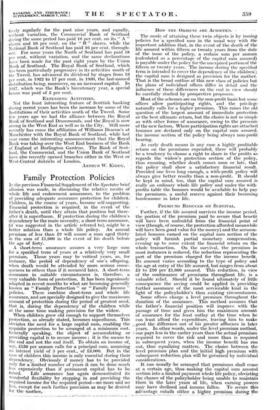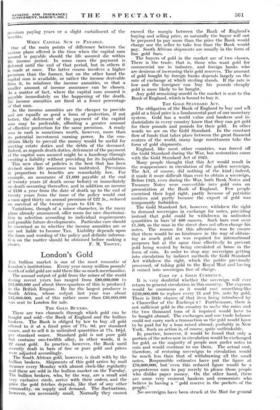Family Protection Policies
Ix the previous Financial Supplement of the Spectator brief allusion was made, in discussing the relative merits of whole, life and endowment assurances, to the problem of providing adequate assurance protection for children. Children, in the course of years, become self-supporting. Financial protection is required, in the event of the father's death, until they attain that position but there- after it is superfluous. If protection during the children's dependency be-the main necessity; a short term assurance, (it was suggested in the article referred to), might be a better solution than a whole life policy. An annual premium of less than £9 will assure a man aged thirty in the sun of £1,000 in the event of his death before the age of forty. A short-term assurance assures a very large sum for a specified term of years at a relatively very small premium. Those years may be 'critical years, as, for instance, the period of dependency of one's offspring, when death would be attended by more serious conse- quences to others than if it occurred later. A short-term assurance in suitable circumstances is, therefore, a very valuable form of protection. It has been ingeniously adapted in recent months to what are becoming generally known as "- Family Protection " or " Family- Income " policies. These combine short-term and whole life assurance, and are specially designed to give the maximum amount of protection during the period of greatest need, that is, during the dependency of the children while at the same time making provision for the widow.
When children grow old enough to support themselves protection, as already stated, becomes superfluous. This obviates the need for a large capital sum, enabling the requisite protection to be arranged at a minimum' cost. Generally speaking, the object - of • accumulating or providing capital is to secure income ; it is the means to the end and not the end itself. To obtain an income of, say, 1150 per annum calls for a principal_sum, assuming an interest yield of 5 per cent., of £3,000. But: hi the case of.children this income only essentialduring their . dependency. Obviously if money has to be provided only for a limited number of years it can be done much less expensively than if permanent capital. has to be mised. Life assurance ha's again demonsfrated its Wonderful flexibility by stepping in and providing the required income for the required period—no more and no less, except for such further provision as may be desired for the--mother.' _
- -HOW --THE -OBJECTS ARE ACHIEVED. -•
The mode of attaining these twin objects is by issuing policies for 'a specified sum in the usual way with the important addition that, in the event of the death of the life assured within fifteen or twenty years from the date of the issue of the policy, a certain sum per annum (calculated as a percentage of the capital sum assured' is payable under the policy for the unexpired portion of th fifteen or twenty years. - The income during the specified term is intended to cover the dependency of the childrenf; the capital sum is designed as provision for the mother. That is the broad outline of this new class of policies but the plans of individual offices differ in detail and the influence of these differences on the end in view should be carefully studied by prospective proposers.
Most of the schemes are on the non-profit basis but some offices allow participating rights, and the privilege naturally calls for a higher premium. This raises the old question of the largest amount of immediate protectioh or the best ultimate return, but the choice is not so simple as with other forms of assurance, owing to the presence of the new factors. Where participation rights are attached bonuses are declared only on the capital sum assured, the income section of the policy being always non-profit bearing. As early death means in any case a highly profitable return on the premiums expended, there will probatify be a tendency to choose a right to share in the profits as regards the widow's protection section of the policy, thus ensuring, whether death comes soon or late, that the policy shall show a satisfactory financial result. Provided one lives long enough, a with-profit policy will always give better results than a non-profit. It should be kept in mind, too, that the capital sum assured is really an ordinary whole life policy and under the with- profits table the bonuses would be available to help pay the premiums, a useful reserve against their becoming burdensome in later life.
PREMIUMS REDUCED ON SURVIVAL.
Further, if the life assured survives the income period, the portion of the premium paid to secure that benefit will have been unfruitful from the financial point of view (though, of course, the protection afforded meanwhile will have been good value for the money) and the accumu- lated bonuses earned on the capital sum section of the policy will furnish partial monetary 'compensation, evening up to some extent the financial return on the whole transaction. On the survival, the premium in most instances is reduced, the reduction representing the part- of the premium charged for the income benefit. Its amount varies according to the type of policy and the age at entry of the life assured, but ranges from about £3 to £10 per £1,000 assured. This reduction, in view of the continuance of ,premiums throughout life, is a valuable relief. Should it be found ultimately of little consequence the saving could be applied in providing further assurance of the most serviceable kind in the light of the policyholder's then existing circumstances. Some offices charge a level premium throughout the duration of the assurance. This method assumes that the father's financial position will improve with the passage of time and gives him the maximum amount of assurance for the least outlay at the time when he can least afford the expenditure, leaving him to make „ good the difference out of his greater affluence in later years. In other words, under the level premium method, i one pays less in the earlier years than the actual premium required to cover the risk and more than is required in subsequent years, when the income benefit has run out, thus equalizing matters.. The choice between the level premium- plan and, the initial high premium with subsequent reduction plan will be governed by individual considerations. _ -It _can- usually ,he arranged that premiums shall -cease at a certain age, thus-Braking the capital sum assured section into a limited payment whole life policy, obviating the_ chance of the policyholder. being unable to maintain ' them in the later years of life, when earning pow.ers may have declined and income fallen. To secure this advantage ,entails either a" hillier premium during the premium paying years or a slight curtailment of the benefits. •
WHEN CAPITAL SUM IS PAYABLE. •
One of the main points of difference between the various plans offered is the time when the capital sum ' assured is payable should the life assured die within the income period.. In some cases the payment is ; deferred until the end of that period, but in others it is made at once. The latter course involves a higher premium than the former, but on the other hand the capital sum is available, or rather the income derivable from it, to reinforce the income annuities, so that a smaller amount of income assurance can be chosen. As a matter of fact, where the capital sum assured is payable immediately on the happening of the death, the income annuities are fixed at a lesser percentage of that sum.
As the income annuities are the cheaper to provide and are equally as good a form of protection, if not better, the deferment of the payment of the capital: sum may be preferable, affording a greater amount of effective protection for the same premium. A ready sum in cash is sometimes worth, however, more than its potential investment earning power. In the con- ditions likely to prevail the money would be useful for meeting estate duties and the debti of the deceased. Indeed, as regards death duties, deferment of the payment of the capital sum assured might be a handicap through creating a liability without providing for its liquidation.
This new class of policies is the best that has been devised since life assurance was instituted. Premiums in proportion to benefits are remarkably low. For example, an assurance of £1,000 payable at the end of twenty years (if death occur before) or immediately on death occurring thereafter, and in addition an income of £150 a year from the date of death up to the end of twenty years from the issue of the policy would cost a man aged thirty an annual premium of £22 5s., reduced on survival of the twenty years to £16 9s.
Variations, though of a minor character, in the many plans already announced, offer room for nice discrimina- tion in selection according to individual requirements and possible future developments. Particular care should he exercised as to whether the income annuities are or are not liable to Income Tax. Liability depends upon the form and wording of the policy and definite informa- n on the matter should be obtained before making a



























































 Previous page
Previous page